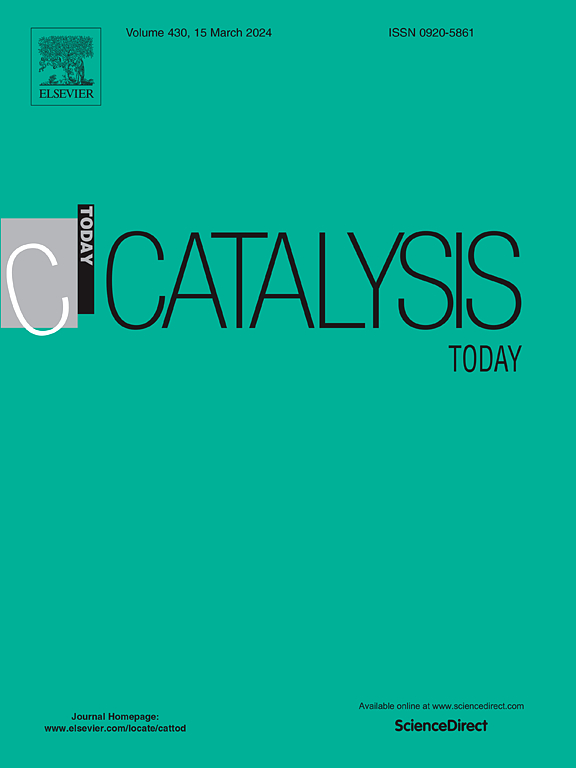The relevant role of TiO2 for enhancing the Ru/TiO2-catalyzed conversion of levulinic acid to γ-valerolactone
IF 5.2
2区 化学
Q1 CHEMISTRY, APPLIED
引用次数: 0
Abstract
Levulinic acid (LA), that can be obtained from the acidic hydrothermal carbonization of biomass, is a platform molecule with several possibilities to be transformed into useful chemicals. The hydrogenation of LA to γ-valerolactone (GVL) requires a bifunctional catalyst, with both metallic and acidic active sites. In this study, TiO2 was the selected support due to its acidic properties, and Ru was the metal phase due to its high activity in this reaction. 1 wt% Ru/TiO2 catalysts were prepared using either commercial P25 or TiO2 prepared by hydrothermal (HT) synthesis (with or without the addition of a low concentration HCl solution). The catalysts were used without previous reduction in catalytic tests carried out under mild reaction conditions, and the influence of the surface chemistry, porosity, crystalline structure, and oxygen vacancies of the TiO2 supports, as well as the interaction between Ru and the TiO2 supports were studied. All the catalysts demonstrated promising results under mild reaction conditions (24 – 65 % GVL yield), being the catalytic activity enhanced when using the Ru/HT-TiO2 catalysts compared to the analogous Ru/P25. This indicates that a higher surface area of the supports improves the catalytic performance. High GVL yield (65 %) and excellent reusability over three cycles were achieved with the best catalyst, synthesized by HT without using HCl solution. Although isolating the effect of individual variables remains challenging, our results have shown that the surface chemistry composition and content of the synthesized TiO2 supports have some influence on the formation of Ru0 on them.
TiO2在Ru/TiO2催化乙酰丙酸转化为γ-戊内酯中的相关作用
乙酰丙酸(LA)可以从生物质的酸性水热碳化中获得,是一种平台分子,具有多种转化为有用化学品的可能性。LA加氢生成γ-戊内酯(GVL)需要具有金属和酸性活性位点的双功能催化剂。在本研究中,TiO2因其酸性而被选择为载体,Ru因其在该反应中的高活性而被选择为金属相。1 wt% Ru/TiO2催化剂分别使用商用P25或水热(HT)合成的TiO2(添加或不添加低浓度的HCl溶液)制备。在温和反应条件下,不进行还原,使用催化剂进行催化测试,研究TiO2载体的表面化学、孔隙度、晶体结构、氧空位以及Ru与TiO2载体之间的相互作用对催化剂的影响。所有催化剂在温和的反应条件下(GVL产率为24 ~ 65%)均表现出良好的效果,与类似的Ru/P25相比,使用Ru/HT-TiO2催化剂的催化活性增强。这表明载体的表面积越大,催化性能越好。在不使用HCl溶液的情况下,采用高温催化合成的最佳催化剂,GVL收率高达65%,且可重复使用3次。虽然分离单个变量的影响仍然具有挑战性,但我们的研究结果表明,合成的TiO2载体的表面化学组成和含量对其上Ru0的形成有一定的影响。
本文章由计算机程序翻译,如有差异,请以英文原文为准。
求助全文
约1分钟内获得全文
求助全文
来源期刊

Catalysis Today
化学-工程:化工
CiteScore
11.50
自引率
3.80%
发文量
573
审稿时长
2.9 months
期刊介绍:
Catalysis Today focuses on the rapid publication of original invited papers devoted to currently important topics in catalysis and related subjects. The journal only publishes special issues (Proposing a Catalysis Today Special Issue), each of which is supervised by Guest Editors who recruit individual papers and oversee the peer review process. Catalysis Today offers researchers in the field of catalysis in-depth overviews of topical issues.
Both fundamental and applied aspects of catalysis are covered. Subjects such as catalysis of immobilized organometallic and biocatalytic systems are welcome. Subjects related to catalysis such as experimental techniques, adsorption, process technology, synthesis, in situ characterization, computational, theoretical modeling, imaging and others are included if there is a clear relationship to catalysis.
 求助内容:
求助内容: 应助结果提醒方式:
应助结果提醒方式:


